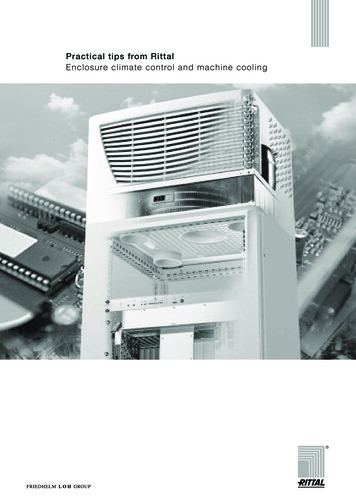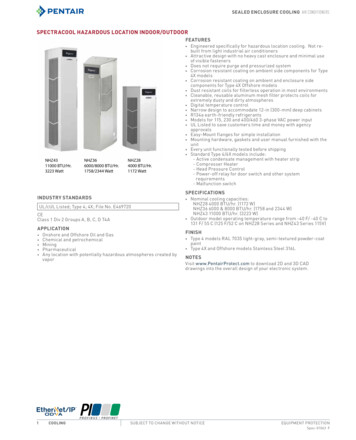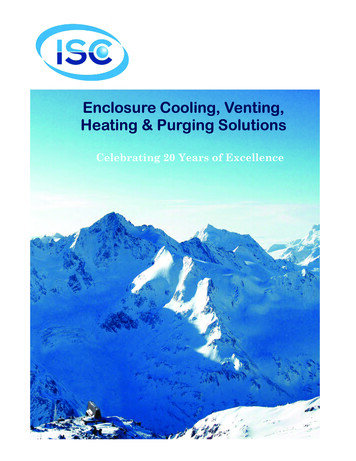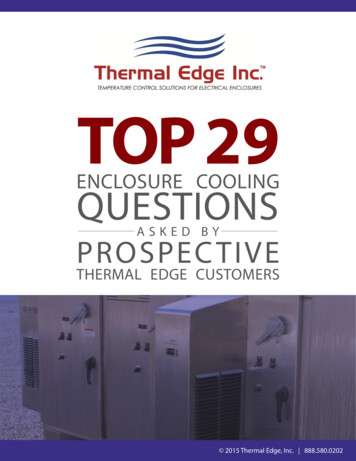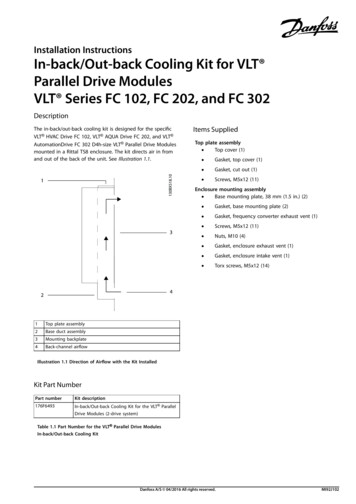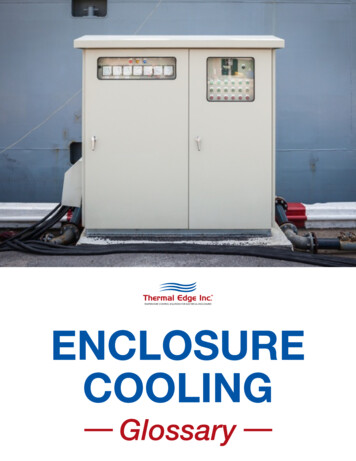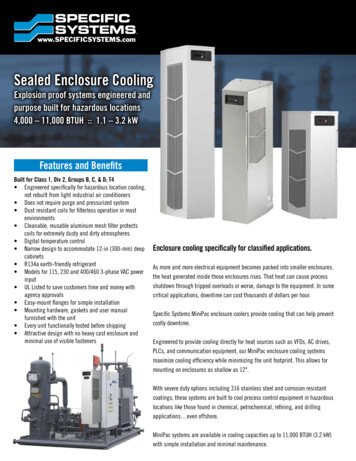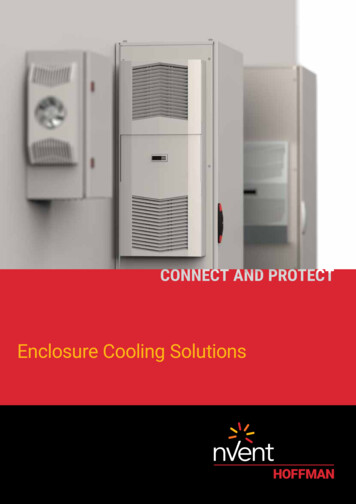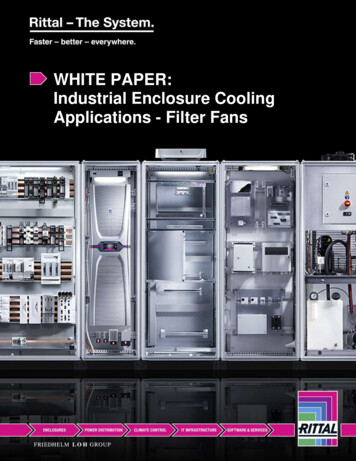
Transcription
WHITE PAPER:Industrial Enclosure CoolingApplications - Filter Fans
Industrial Enclosure Cooling Applications – Filter FansExecutive SummaryImproved efficiencies for electronic components have been outpaced by a market demand tomake those components smaller. The result is higher density systems that require activecooling solutions. Industrial enclosure climate control systems such as fans, air-to-air heatexchangers, air-to-water heat exchangers, and air conditioners are used to ensure continuedoperation and to prolong electrical equipment life.What follows is an examination of the simplest enclosure climate control system, the filter fan.First, however, it will help to understand the different ways in which heat is transferred and whyclimate control of electrical systems is critical. The reasons why one climate control system ischosen over another is also explored. Then sample calculations are shown for heat transferusing forced air. Finally, a review of how the application of filter fans affects coolingperformance is given.How Heat is TransferredHeat is transferred through 3 different methods – convection, conduction, and radiation.Conduction occurs in all phases of matter – solids, liquids, gasses, and plasmas. Thermalradiation can occur even in the absence of a medium. Convection is the transfer of heat via afluid (liquid or gas). More specifically, convection can be broken down into two major types –natural and forced. Natural convection as the name implies describes the flow of a fluid causedby buoyancy forces resulting from density changes (due to temperature changes) of that fluid.Forced convection describes the flow of a fluid caused by some external means such as a fan orpump.Natural ConvectionForced Convection2
Industrial Enclosure Cooling Applications – Filter FansWhy Climate Control is NeededElectronics fail for many reasons including contamination by airborne particulates such as oiland dust; however, the main reason for failure is heat. As such, careful scrutiny of climatecontrol methods is critical to achieving long-term operational effectiveness of these systems.Using the Arrhenius principle, the service life of components can be estimated to be halved forevery 10 C ( 10 K 10 C) increase in temperature above the recommended maximum.When to Use a Filter FanFilter fans are the most desirable active enclosure cooling method due to the ease of installationand cost effectiveness, both in acquisition cost and operating cost. To better explain when theuse of a filter fan is optimal it is necessary to understand where filter fans fit within the climatecontrol solution spectrum.The choice of which climate control product will work with a given application is dependent ontwo main factors: temperature and the cleanliness of the environment. The following chart plotsthe ideal scenarios for each of the major climate control protection methods.3
Industrial Enclosure Cooling Applications – Filter FansTemperature 580Air-to-WaterHeat ExchangersAir ConditionersFilter FansAir-to-AirHeat ExchangersCoolCleanEnvironmentDirty / OilyThe estimations made here have no reflection on the overall usefulness or suitability of theproduct. In other words, don’t be misled by the scale of the chart. At first glance filter fans mayseem to have a narrow window of applications but the fact is there are many instances wherefilter fans are successfully deployed as the primary climate control option.In addition to the temperature and cleanliness of the environment, the selection of climatecontrol is also dependent on the type rating of the enclosure and the availability of chilled water.The flow chart on the next page provides a general outline of this selection process.4
Industrial Enclosure Cooling Applications – Filter FansLouvered grilland/orRoof ventNoIs ambienttemperatureless thanenclosuretemperature?YesIs NEMA 12 (orbetter)protectionrequired?Air-to-air heatexchangerYesYesNoIs theenvironmentmildly dirty?Is theenvironmentextremely dirty?YesNoFilter fanNoIs the ambienttemperatureover 130 F.NoAir conditionerYesIs chilled wateravailable onsite?NoChiller systemYesAir-to-water heatexchanger5
Industrial Enclosure Cooling Applications – Filter FansDetermining Required AirflowGiven a set of parameters it is possible to determine the required airflow necessary to meetcooling expectations. This airflow is volumetric and given in units of cubic meters per hour(m3/hr.) or cubic feet per minute (cfm). There are three main methods for determining thisvolumetric airflow: Computational Fluid Dynamic (CFD) analysis, manual calculations, andgeneral sizing software.Computational Fluid Dynamic AnalysisThe first method to determine the amount of airflow needed for a forced air application is to useCFD software. Given the input of control variables, CFD uses numerical methods andalgorithms to calculate the interaction of liquids and gases. Specifically CFD can provide avisual representation of these airflows for analysis.CFD software is expensive and requires some expertise to correctly set up input variables aswell as to properly analyze the output. It is useful for determining how air will flow for a given fanand filter combination however is overkill for simple selection of a fan given certain heat loads.6
Industrial Enclosure Cooling Applications – Filter FansManual MethodThe assumption that air within the enclosure is a uniform temperature (hot spots are quicklydissipated into the surrounding air of the internal enclosure) allows for a manual method that canalso be used to determine the required airflow for a given application. With the input of severalvariables, (enclosure surface area, internal enclosure temperature, ambient temperature, andheat load generated by installed components) it only takes a few formulas and knowncoefficients to calculate what size fan is needed. Specific values for coefficients and otherattributes mentioned below can be found within various engineering websites and heat transferor thermodynamic textbooks.Enclosure Surface AreaEnclosure size plays a significant role in climate control applications. An enclosure with moresurface area will dissipate a greater amount of heat than an enclosure with less surface area.The installation orientation is also a contributing factor. Fully unobstructed surface areas willdissipate a greater amount of heat than those areas which are facing a wall. The formulas forcalculating effective enclosure surface area (A) are specified in DIN 57 660 part 500.Internal Enclosure TemperatureThe internal enclosure temperature (Ti) is the desired maximum temperature of the enclosurewhen the system is operating at full load.Ambient TemperatureThe ambient temperature (Ta) is the maximum temperature of the air surrounding the enclosure.Remember, for a filter fan application this temperature must be less than the internal enclosuretemperature.Heat Load Generated by Internal ComponentsThe heat load generated by internal components (Qv) can be formulated in a few ways. Themost common method is done early during system engineering. Simply add the total heat loss7
Industrial Enclosure Cooling Applications – Filter Fansof all components (drives, starters, circuit breakers, etc.) using information supplied by thecomponent manufacturers. The other method is done after a system has been installed. Usinga thermometer, the temperatures of the inside (Tmi) of the enclosure and the outside (Tma) air aremeasured. Knowing these temperatures allows for the calculation of the heat being generatedwithin the enclosure, all of which is passing through the enclosure walls and into the ambient air.The following equation is used.̇Where:̇()Note, the overall heat transfer coefficient (U) is dependent on the individual heat transfercoefficients of the hot internal air and cool external air as well as the thermal conductivity andthickness of the enclosure material (generally steel). The calculation of this value is not difficultbut is beyond the scope of this paper.Heat Loss via Enclosure SurfaceAt the desired enclosure temperature, most of the heat will be cooled by the fan but a portion ofthat heat is still lost through the enclosure surface. Therefore the same equation may be usedto determine the amount of heat lost to the surrounding air, but this time the desired internalenclosure temperature and ambient temperature are used.̇Where:̇()Required Cooling OutputNow, the required cooling output can be calculated. This is the total heat minus the heat lost viaenclosure surface.̇̇̇Where:̇̇̇8
Industrial Enclosure Cooling Applications – Filter FansRequired Volumetric Flow of Filter FanThe required volumetric flow needed to cool the remaining heat in the enclosure is calculatedusing the equation for sensible heat.̇̇Where:̇̇()This equation may be used with any fluid, but in this case the fluid is air. Mass flow can beconverted into volume flow if the density is known. Note, both the specific heat and density ofair will change with both temperature and elevation (pressure) and each should be taken intoaccount. To coincide with most fan manufacturers published data, units of flow per second needchanged to flow per hour as well.̇̇ Substituting for M in the first equation gives:̇̇Rearranging for V gives the final equation which can be solved to obtain the required volumetricairflow necessary to cool the enclosure to the desired temperature.̇̇Where:̇̇ )()9
Industrial Enclosure Cooling Applications – Filter FansGeneral Sizing SoftwareIn review, the CFD method is expensive, requires analysis, and is generally overkill while themanual method involves several equations and takes time to solve. Fortunately there is a thirdway. The variables used in the manual method can be input into a general sizing program suchas Rittal Therm 6.3. Therm makes two assumptions to the manual method equations. Althoughit can be changed, Therm uses a default value of 5.5 W/m2K for the overall heat transfercoefficient of a steel enclosure. Also Therm only varies the specific heat and density of airbased on elevation, not temperature. These are sound assumptions since the overall heattransfer coefficient, specific heat, and density of air are not very different within the small rangeof temperatures used in most real world enclosure cooling applications.Therm 6.3 is available for download here. Mobile versions are also available.Filter Fan SpecificationsBelow is a typical specifications table for filter fans.10
Industrial Enclosure Cooling Applications – Filter FansThis table has valuable information necessary to select filter fans. Along with the requiredairflow calculated in the previous section, power requirements must also be taken intoconsideration. The choice between AC or DC voltages will result in different airflows. Theoperating frequency (50 Hz or 60 Hz) also is a factor. Lastly, the physical dimensions of the fanare listed such that compatibility with the enclosure can be determined.Most importantly the volumetric airflow is listed as “air throughput (unimpeded airflow)”. Tobetter understand what this means, a review of the factors that affect airflow is necessary.Filter Fan PerformanceThe primary components composing a filter fan assembly are the housing, fan motor, and thefan blades. As the fan blades rotate, air is being directed (pushed) and this movement of aircreates pressure.Figure 1Figure 2In Figure 1 above, the airflow passes from the inlet to outlet side of the fan. The inlet sideincludes the louvers and filter mat while the outlet side is through the motor and blade assembly.This illustrates the “unimpeded airflow” mentioned in the chart above. Please note not all filterfan manufactures list unimpeded airflow this way. Some use the motor and fan blade assemblyonly and give higher values due to the absence of resistance introduced with the louver and filtermat assembly.An unimpeded fan operates at zero static pressure and provides maximum air flow. When fittinga filter fan and outlet filter onto an enclosure (Figure 2) the fan must overcome resistance thatimpedes the airflow. This resistance comes in the form of a pressure drop due to the internalcomponents installed within the enclosure (densely populated enclosures provide physicalobstructions) and more importantly the outlet filter. The fan counters this pressure loss byincreasing pressure which in turn decreases airflow.Using part number 3237.110 in the specifications table on the previous page as an example, thisfan operates on single phase current, 115 V at 50 or 60 Hz. The unimpeded airflow is 12 cfm(20 m3/hr) at 50 Hz and 15 cfm (25 m3/hr) at 60 Hz. To understand how the fan will performunder the real world scenario depicted in Figure 2, it is necessary to review the fan’s11
Industrial Enclosure Cooling Applications – Filter Fansperformance chart, sometimes referred to as a “fan curve”. This chart shows how a particularfan performs under different pressure measurements.Figure 3 shows an actual performance chart for Rittal filter fan 3237.110 (60 Hz). The bluecurve represents the airflow of filter fan 3237.110 with a standard filter mat and the solid blackcurve represents the impedance for outlet filter 3237.200. The point where these 2 curvesintersect is the actual airflow. So filter fan 3237.110 installed on an enclosure with outlet filter3237.200 will have an actual airflow of about 10.6 cfm (18 m3/hr). This is the value whichshould be used when choosing a filter fan for a specific application, not the 15 cfm (25 m3/hr)unimpeded rating. Note, any physical obstructions within the enclosure are considered minimaland are ignored but actual results may vary.Figure 3 - Rittal filter fan 3237.110 performance chartFan DesignFans can be axial, centrifugal (radial), or a mix of the two. Propeller shaped axial fans direct airfrom inlet to outlet along a line parallel to the rotation of axis. Axial fans are the most commonlyused method to cool individual electronic components. Blade designs are optimized to work at12
Industrial Enclosure Cooling Applications – Filter Fansspecific speeds resulting in very quiet operation; however, axial fans do not handle higherpressures so efficiency drops dramatically beyond their optimized speed. With a centrifugal fanthe air flows in a conical manner on the inlet side and is released perpendicular to the rotation ofaxis on the outlet side. A centrifugal fan will operate at a higher pressure, but at lower airflows.Hybrid fans offer advantages of both axial and centrifugal fan types. The intake is axial while theexhaust is diagonal, resulting in a fan that can be used at higher pressures but still deliver highairflow. For industrial enclosure cooling applications the diagonal fan provides greater pressurestability resulting in a more constant airflow, even with a contaminated filter mat. The diagonalairflow also promotes a more even air airflow distribution throughout the enclosure.Airflow pattern for a diagonal fanEC FansA typical filter fan with an AC induction motor is usually controlled by a separate bi-metalthermostat that turns the fan on and off based on the temperature within the enclosure. Whenturned on, the fan runs at a steady speed determined by the design of the motor and voltageapplied to it. The temperature difference between when the thermostat switches on and thenback off is known as the hysteresis. This hysteresis is a product of the bi-metallic design of thethermostat and prevents short cycling of the fan; however, the trade-off is the fan will run longerthan needed. Also, filter fans are typically sized for a worst case scenario which means they aregenerally oversized for their most common use, leading to more energy inefficiency.Tighter temperature control may be achieved through the use of another fan type, the EC fan. Afan with EC (electrically commutated) technology is one that utilizes a brushless DC motor andexternal electronics to power the fan. The precise electronically controlled current produces amore energy efficient fan; however, the largest energy gains come from the ability to easilycontrol the speed. A separate controller with an integral electronic thermostat can send variable13
Industrial Enclosure Cooling Applications – Filter Fansinputs to the electrical commutation circuit allowing the fan to speed up and slow down asneeded. This eliminates the superfluous energy use caused by a thermostat with a hysteresis.Push vs. PullMost modern filter fans for industrial enclosure applications can be set up to blow air into or blowout of the enclosure. The orientation of the airflow has an effect on cooling performance andmore. A diagonal fan blowing air into an enclosure will result in a more desirable turbulentairflow which promotes an even distribution throughout the enclosure and reduces the chancefor hot spots. Reversing the diagonal fan to blow out will result in a more laminar flow, therebynullifying this advantage. Another advantage to blowing air in is that it will positively pressurizethe enclosure with all air entering through the filter mat. Pulling the air out of the enclosure willresult in a negatively pressurized enclosure giving rise to the possibility that air (and with it dust)could leak into the enclosure from sources other than the filter.ConfigurationsDifferent fan and filter configurations will produce different airflows. A fan manufacturer mayonly show performance curves for a few of these combinations but assumptions can be made toestimate others.Standard configurationThe standard installation configuration involves a single filter fan and exhaust outlet filter. Fanmanufacturers will generally provide performance curves showing at least this one combination.The CFD output below shows an example of this standard configuration.CFD temperature distribution: single fan filter14
Industrial Enclosure Cooling Applications – Filter FansLarger outlet filtersThe addition of an outlet filter to a system results in a pressure drop that the fan must overcome.Doubling the surface area of the outlet filter will generally result in a pressure drop reduction ofat least 50% and often much more for higher flow fans. This reduced pressure drop lessons theburden of the fan to increase pressure however the overall effect is small since a pressureincrease of four times is needed to double the airflow. Looking at Figure 3 again, there is animpedance curve for two outlet filters, which results in an airflow of around 11.7 cfm (20 m3/hr);only a 10% increase over the 10.6 cfm (18 m3/hr) for one outlet filter. Larger filter fans willexhibit a greater increase but generally never more than a 20% improvement.Fans in series (push-pull)Replacing the outlet filter of a system with an equal size fan will decrease the static pressureinside the enclosure; however, a fan can never go beyond its unimpeded rating. CFD analysissuggests the result of this configuration is equal to the unimpeded rating of the fan minus 2.5-3%but a more conservative value of 4-5% is commonly used. Looking at Figure 3 again, theunimpeded rating is 14.7 cfm (25 m3/hr). If the outlet filter is replaced with another 3237.110 fan,the output would increase from 10.6 cfm (18 m3/hr) to 14.1 cfm (24 m3/hr) - unimpeded rating of25 m3/hr minus 4%. This technique is most beneficial for enclosures with high systemimpedance.CFD temperature distribution: fans in seriesFans in parallelThe final way fans may be configured is in parallel, two or more fans side-by-side installed alongwith two or more exhaust filters. In this scenario the airflow is nearly doubled and has the besttemperature distribution, although systems with higher impedance will exhibit less improvement.15
Industrial Enclosure Cooling Applications – Filter FansCFD temperature distribution: fans filters in parallelCertificationsOne key advantage of filter fans over passive ventilation is the ability to maintain NEMA(National Electrical Manufacturers Association) or UL (Underwriters Laboratories) environmentalType ratings. With filter mats installed, the fan and filter combination provides a dust tight ULType 12 barrier. The addition of fan hoods makes it possible to achieve Type 3R rain tight andType 4/4X outdoor ratings. Configurations utilizing these hose-proof-hoods will require the fansto operate at increased pressure, which in turn reduces airflow. This slight reduction can beseen in Figure 3 above.UL certification of filter fans is achieved after testing the individual product features such ashousing (QMFZ2: Plastics - Component), gasket (JMST2: Gasket Materials - Component), fan(GPWV2: Fans, Electric - Component), and others including motor, and terminal block. Theentire assembly is generally UL recognized to NITW2: Industrial Control Panel EquipmentComponent, but may also be UL listed to FTTA – Environmental-rated Accessories forEnclosures. It is important to note those fans recognized to NITW2 should not be consideredinferior to the listed FTTA versions because filter fans are not required to be “proceduredescribed”, a process in which an integrator must pay a fee to have recognized componentsadded to their UL files. Instead UL 508A Table SA1.1 Section 26.2.3 states a fan kit recognizedto NITW2 only needs to be “installed according to manufacturer instructions”.16
Industrial Enclosure Cooling Applications – Filter FansConclusionHeat is a deadly enemy of electronics. It only takes an increase of 18 F ( T 10 C) to reduce thelife expectancy of electronic components by 50%, making the removal of heat the main priority toensure continued operation of electronic systems. The filter fan has long been the traditionalfront line defender keeping heat at bay. While filter fans can’t be used for every application, theyare the most desirable active enclosure cooling method due to the ease of installation andoverall cost effectiveness.Although filter fan selection may seem trivial, the costs associated with a system failure due toheat more than justifies a close review of cooling needs. In addition to the cooling requirement,other factors that play a role in the selection of filter fans are the environmental type rating of theenclosure and power (voltage and frequency) requirements of the system. It is recommended toutilize general sizing software to determine if filter fans are the proper choice for a givenapplication. If after sizing there are no apparent standard solutions, estimations can be made forspecial configurations such as fans in series. If all else fails, there are other climate controlsolutions which may work such as air conditioners or heat exchangers.17
Industrial Enclosure Cooling Applications – Filter Fans18
Industrial Enclosure Cooling Applications - Filter Fans 7 Manual Method The assumption that air within the enclosure is a uniform temperature (hot spots are quickly dissipated into the surrounding air of the internal enclosure) allows for a manual method that can also be used to determine the required airflow for a given application.
